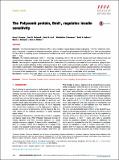The Polycomb protein, Bmi1, regulates insulin sensitivity

View/
Author
Cannon, Corey E.
Titchenell, Paul M.
Groff, David N.
Birnbaum, Morris J.
Stoffers, Doris A.
Published Version
https://doi.org/10.1016/j.molmet.2014.08.002Metadata
Show full item recordCitation
Cannon, Corey E., Paul M. Titchenell, David N. Groff, Abdelfattah El Ouaamari, Rohit N. Kulkarni, Morris J. Birnbaum, and Doris A. Stoffers. 2014. “The Polycomb protein, Bmi1, regulates insulin sensitivity.” Molecular Metabolism 3 (8): 794-802. doi:10.1016/j.molmet.2014.08.002. http://dx.doi.org/10.1016/j.molmet.2014.08.002.Abstract
Objective: The Polycomb Repressive Complexes (PRC) 1 and 2 function to epigenetically repress target genes. The PRC1 component, Bmi1, plays a crucial role in maintenance of glucose homeostasis and beta cell mass through repression of the Ink4a/Arf locus. Here we have explored the role of Bmi1 in regulating glucose homeostasis in the adult animal, which had not been previously reported due to poor postnatal survival of Bmi1−/− mice. Methods: The metabolic phenotype of Bmi1+/− mice was characterized, both in vivo and ex vivo. Glucose and insulin tolerance tests and hyperinsulinemic-euglycemic clamps were performed. The insulin signaling pathway was assessed at the protein and transcript level. Results: Here we report a negative correlation between Bmi1 levels and insulin sensitivity in two models of insulin resistance, aging and liver-specific insulin receptor deficiency. Further, heterozygous loss of Bmi1 results in increased insulin sensitivity in adult mice, with no impact on body weight or composition. Hyperinsulinemic-euglycemic clamp reveals increased suppression of hepatic glucose production and increased glucose disposal rate, indicating elevated glucose uptake to peripheral tissues, in Bmi1+/− mice. Enhancement of insulin signaling, specifically an increase in Akt phosphorylation, in liver and, to a lesser extent, in muscle appears to contribute to this phenotype. Conclusions: Together, these data define a new role for Bmi1 in regulating insulin sensitivity via enhancement of Akt phosphorylation.Other Sources
http://www.ncbi.nlm.nih.gov/pmc/articles/PMC4216405/pdf/Terms of Use
This article is made available under the terms and conditions applicable to Other Posted Material, as set forth at http://nrs.harvard.edu/urn-3:HUL.InstRepos:dash.current.terms-of-use#LAACitable link to this page
http://nrs.harvard.edu/urn-3:HUL.InstRepos:13454853
Collections
- HMS Scholarly Articles [17922]
Contact administrator regarding this item (to report mistakes or request changes)


